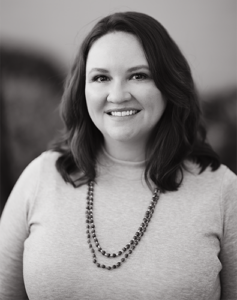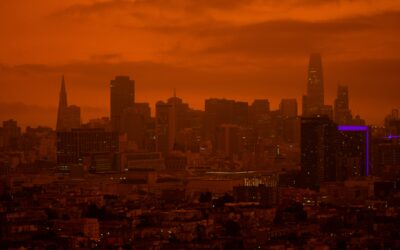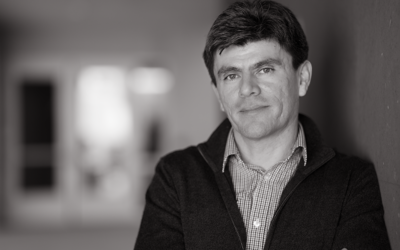
Ariel Choinard, M.A., started at DRI in February 2023 as the project coordinator for the California-Nevada Adaptation Program (CNAP) and the new Southern Nevada Heat Resiliency Lab. She is working with Tamara Wall, Ph.D., to build connections between scientists, community members, and community organizations to co-produce solutions, adaptations, and resilience to climate hazards. Choinard came to DRI after working as the Urban Heat Resilience Fellow for Clark County and is based at DRI’s Las Vegas campus.
Below is a brief Q&A with Choinard about her background, her work, and how she unwinds from the pressures inherent in building climate resiliency in some of the fastest-warming parts of the country. The interview has been edited for length and clarity.
DRI: Tell us about your background and what brought you to DRI.
Choinard: I spent about 10 years of my professional life working in sustainable and regenerative agriculture in Colorado and Los Angeles. The connection between climate change, food systems, and human systems led me to pursue a master’s degree in urban sustainability, which I did at Antioch University in LA where I focused on the intersection of climate change and disaster in urban areas. I ended up doing my capstone project at the LA City Office of Resilience, and I worked on extreme heat — that was kind of my introduction to climate hazards and how they interact with urban systems. That Office did some great work on both emergency responses and mitigation type responses to extreme heat.
We moved to Las Vegas in 2018 and I started a Ph.D. program, but the challenges of home-schooling my kid during COVID burnt me out and I left the program. I ended up finding a position as the Urban Heat Resilience Fellow for Clark County. Since I was familiar with working on extreme heat, my skills translated really well to that role. And I got to know all the different players, organizations, and agencies that are involved in working on heat here in Las Vegas.
The challenge around heat here is that nobody really owns it. Prior to the heat lab, heat didn’t necessarily have a central home. A lot of agencies and organizations had pieces of the work that they did, but there wasn’t necessarily a dedicated space for coordination or collaboration.
DRI: What are the goals of the Southern Nevada Heat Resilience Lab?
Choinard: The goal is to provide that collaboration and convening space for people who are working on heat in different capacities. It’s also a space where we can start to fill knowledge and data gaps around heat, because the heat lab can leverage all the resources at DRI to help answer some of the unanswered questions. But I think the biggest goal is to co-produce solutions, adaptations, and community resilience to a number of different climate hazards.
I learned from my work at the county that the folks who are most impacted by heat here in the metro area have not had a clear enough voice in talking about the response to extreme heat. These are folks who live in our urban heat island neighborhoods that are on average about 11 degrees hotter than other neighborhoods here — that is a big deal when it’s 115 degrees. So, the heat lab has been building trust relationships with the residents that are most impacted, with the community-based organizations that serve those residents, to give them a chance to articulate for themselves what the challenges are, what their needs are, and what types of interventions are going to work best for them.
DRI: Can you give us some specific examples of your day-to-day work and how you’re bringing people together?
Choinard: I’m establishing a heat working group to connect people in a way that’s practical, and share out information, and build connections across the communities. I worked with the Nevada Office of Minority Health and Equity to put together two community listening sessions to give these communities a chance to share their challenges, their priorities and their needs around extreme heat. We held our first listening session at the end of August, and we spoke with leaders from community-based organizations that serve our heat-burdened residents, primarily in East Las Vegas.
The Regional Transportation Commission did a heat vulnerability study and found that our most heat-impacted neighborhoods are primarily on the east side of Metro Las Vegas. That’s partially because of the built environment and inequality and inequities within the metro area, but also because the east side of town is a bit lower in elevation. Our second listening session is taking place from 6-8pm on October 16th at the East Las Vegas Community Center. I’m really excited to hear what comes out of that listening session.
DRI: What other projects is the Heat Lab working on, and who are you working with at DRI?
Choinard: John Mejia, Ph.D., will be modeling the tradeoffs between water consumption and expanding urban tree canopy. He’ll be nailing down how much tree canopy is needed to actually cool neighborhoods, and quantifying how much water that will take. We’ll also look at other interventions that can help to cool the city, like cool roofs. Unfortunately, cool pavements aren’t a great option for climates like ours because they’ll reflect an overwhelming amount of sunlight on people during the day. I’m also involved in the tree canopy workshop hosted through the Nature Conservancy and the Nevada Department of Forestry.
DRI: What community groups are you collaborating with?
Choinard: We’ve worked with the Nevada Environmental Justice Coalition, the Regional Transportation Commission, Fuentes, Make the Road Nevada, City of Las Vegas, Clark County, City of Henderson, and the American Lung Association, to name a few. Also, the Office of Minority Health and Equity; that partnership has been amazing. We’re also working with The Center, an LGBTQ Center on the east side, as well as the Nevada Center for Excellence in Disabilities.
In years two and three, we really hope to start establishing relationships with our tribal communities and our rural communities, both of which are exposed to the extreme temperatures here in Southern Nevada. As we know, although we’re all exposed to heat, the experience of it is so unequal. And there’s not a lot known about what the needs and desires are for those communities in adapting to, and becoming resilient to, extreme heat.
DRI: How do you envision the Heat Lab evolving in the future?
Choinard: Beyond the initial five years of funding we’ve received through CNAP, we’re not really sure what that’s going to look like, but we would very much like to continue and grow. When you talk about heat resilience, southern Nevada is behind places like Los Angeles, Miami, or Phoenix, who have dedicated heat officers and heat offices — the amount of work that needs to be done here is kind of staggering. Particularly because when you talk about heat, you’re talking about a systemic issue. You’re talking about drought, you’re talking about access to adequate housing, you’re talking about the tradeoffs that people make between putting food on the table or paying for cooling during the summer. This is a very deeply embedded systemic issue.
I think for a long time the attitude was sort of, “Yeah, it’s hot in Las Vegas.” It was just kind of an accepted fact. And as the thinking has changed over the past couple of years, I think people are really waking up to how heat is both a chronic stressor for our communities and can be an acute shock, depending on the magnitude of the heat event. There’s still quite a lot of work to be done to get us to a place where our response, and our structure, and all the needed parts for dealing with extreme heat come together in a fashion that better serves our residents.
DRI: There’s so much to think about on the topic of extreme heat, like the fact that the gauges we rely on for understanding the daily high temperature actually provide the temperature in the shade. How do you think science can help people better understand the risks of extreme heat?
Choinard: I think there’s so much to talk about how temperature is measured — it’s so complicated. The official temperature measurement is done in the shade, and it’s a certain type of sensor — all these different technicalities that come into play, but what we really need to capture is that human experience of heat because that’s what leads to negative health outcomes.
How do you measure how heat impacts the experience of people in their day-to-day life? If the official measure at Harry Reid Airport says it’s 115 degrees, what does that mean for an urban heat island neighborhood? What does it mean if you’re standing without shade at a bus stop waiting to get to work or if you’re walking home from school? There’s a lot of different ways to talk about temperature, but what it really comes down to is those human questions.
DRI: Is there anything else you think is important to mention?
Choinard: I feel like I have lucked into the most amazing job at one of the best places possible. This is what I’ve wanted to do with my life for a long time. And to sit here and actually be able to do it sometimes just blows me away. But what I really want to see is positive change in my community. I want to know that folks who struggle with heat are going to struggle less. You know, in some ways this feels almost like working to keep Las Vegas and Southern Nevada habitable for the next 50 years. I know that’s not necessarily the scope of my project, but it’s a frame of thinking that I bring into it — that we need to think not only in the short term, but the long term as well. So, I hope to see big changes someday. I wish I could be more specific about that, but a lot of what will come to pass is going to be informed by the practitioners, by our community, through engagement with rural and tribal communities. So, as those priorities come to light, I will do whatever I can to make that happen.
DRI: That sounds like a big job and a lot of pressure. How do you have fun outside of work and find ways to relax?
Choinard: That’s a great question. I have a garden that I love — it’s small, and it struggles through the summer just like the rest of us here. But it brings me a whole lot of joy. Growing things will always have a place in my life. I make sourdough bread like every other insufferable millennial. I brew my own ginger beer. I love to ferment vegetables that come out of my gardens and make my own sauerkraut, kimchi, pickles, you name it. And as the weather cools down, I love to hike with my daughter and husband. My daughter is seven and she is so much fun. We just have a great time together. We have three beautiful cats that amaze us to no end: Honey, Biscuit, and Batman (we let our daughter name the new kitten).
We love going to Red Rock, Valley of Fire, and Lake Mead. The landscape out here is so different from what I grew up with in Northern Illinois, and the desert never fails to shock and stun me with how beautiful it is. Nature is a big piece of how I establish my relationship to Las Vegas and unwind and just enjoy life.
More information: The California-Nevada Adaptation Program (CNAP)


